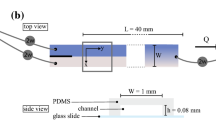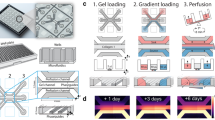Abstract
Endothelial cells are continuously exposed to hemodynamic shear stress, which has been shown to induce an array of physiological responses at the cellular and molecular levels. Uniform high shear stress is protective against vascular diseases such as atherosclerosis which preferentially occur at regions of disturbed flow and low shear. The glucocorticoid receptor (GR), a member of the steroid nuclear receptors with anti-inflammatory functions, has been shown to be activated by shear stress. Using a unique expectation–maximization (EM) algorithm based on Bayesian statistics, we have developed an image analysis algorithm to quantitatively assess GR nuclear translocation based on time-lapse images of green fluorescence protein-tagged GR (GFP-GR) under continuous exposure to a shear stress of 10 or 25 dynes/cm2 as well as to Dexamethasone, a GR agonist. Average fluorescence brightness is generated for nucleus and cytoplasm. Real-time imaging of sheared cells revealed a steady and significant nuclear GFP-GR increase of approximately 20% within 2 h, compared to a rapid 60% increase in Dexamethasone-treated cells within 30 min. Furthermore, we found that that GFP-GR nuclear translocation under shear is not dependent on an intact cytoskeleton. Our image analysis algorithm provides a novel quantitative method to further study shear-sensitive mechanotransduction pathways in endothelial cells.





Similar content being viewed by others
References
Akner, G., A. C. Wikstrom, and J. A. Gustafsson. Subcellular distribution of the glucocorticoid receptor and evidence for its association with microtubules. J. Steroid Biochem. Mol. Biol. 52(1):1–16, 1995.
Blake, G., and P. Ridker. Inflammatory bio-markers and cardiovascular risk prediction. J. Intern. Med. 252(4):283–294, 2002.
Brostjan, C., J. Anrather, V. Csizmadia, G. Natarajan, H. Winkler, et al. Glucocorticoids inhibit E-selectin expression by targeting NF-kappaB and not ATF/c-Jun. J. Immunol. 158(8):3836–3844, 1997.
Burke, B., and C. L. Stewart. Life at the edge: the nuclear envelope and human disease. Nat. Rev. Mol. Cell Biol. 3(8):575–585, 2002.
Christopher, L. A., E. J. Delp, C. A. Bouman, C. R. Meyer, P. L. Carson. In: New approaches in {3D} ultrasound segmentation. Proceedings SPIE and IST Electronic Imaging and Technology Conference 2003: SPIE and IST; 2003.
Davies, P. Flow-mediated endothelial mechanotransduction. Physiol. Rev. 75(3):519–560, 1995.
De Sandre-Giovannoli, A., M. Chaouch, S. Kozlov, J. M. Vallat, M. Tazir, N. Kassouri, P. Szepetowski, T. Hammadouche, A. Vandenberghe, C. L. Stewart, et al. Homozygous defects in LMNA, encoding lamin A/C nuclear-envelope proteins, cause autosomal recessive axonal neuropathy in human (Charcot-Marie-Tooth disorder type 2) and mouse. Am. J. Hum. Genet. 70(3):726–736, 2002.
Dvorak, Z., M. Modriansky, J. Ulrichova, P. Maurel, M. J. Vilarem, J. M. Pascussi, et al. Disruption of microtubules leads to glucocorticoid receptor degradation in HeLa cell line. Cell Signal. 17(2):187–196, 2005.
Eickelberg, O., M. Roth, R. Lorx, V. Bruce, J. Rudiger, M. Johnson, L. Block, et al. Ligand-independent activation of the glucocorticoid receptor by beta2-adrenergic receptor agonists in primary human lung fibroblasts and vascular smooth muscle cells. J. Biol. Chem. 274(2):1005–1010, 1999.
Eriksson, M., W. T. Brown, L. B. Gordon, M. W. Glynn, J. Singer, L. Scott, M. R. Erdos, C. M. Robbins, T. Y. Moses, P. Berglund, et al. Recurrent de novo point mutations in lamin A cause Hutchinson-Gilford progeria syndrome. Nature 423(6937):293–298, 2003.
Frangos, J. A., L. V. McIntire, and S. G. Eskin. Shear stress induces stimulation of mammalian cell metabolism. Biotechnol. Bioeng. 32:1053–1060, 1988.
Galigniana, M. D., J. L. Scruggs, J. Herrington, M. J. Welsh, C. Carter-Su, P. R. Housley, and W. B. Pratt. Heat shock protein 90-dependent (geldanamycin-inhibited) movement of the glucocorticoid receptor through the cytoplasm to the nucleus requires intact cytoskeleton. Mol. Endocrinol. 12(12):1903–1913, 1998.
Glagov, S., C. Zarins, D. Giddens, and D. Ku. Hemodynamics and atherosclerosis. Insights and perspectives gained from studies of human arteries. Arch. Pathol. Lab. Med. 112(10):1018–1031, 1988.
Harrell, J. M., P. J. Murphy, Y. Morishima, H. Chen, J. F. Mansfield, M. D. Galigniana, and W. B. Pratt. Evidence for glucocorticoid receptor transport on microtubules by dynein. J. Biol. Chem. 279(52):54647–54654, 2004.
Inoue, H., K. Umesono, T. Nishimori, Y. Hirata, and T. Tanabe. Glucocorticoid-mediated suppression of the promoter activity of the cyclooxygenase-2 gene is modulated by expression of its receptor in vascular endothelial cells. Biochem. Biophys. Res. Commun. 254(2):292–298, 1999.
Ji, J. Y., H. Jing, and S. L. Diamond. Shear stress causes nuclear localization of endothelial glucocorticoid receptor and expression from the GRE promoter. Circ. Res. 92(3):279–285, 2003.
Ji, J. Y., R. T. Lee, L. Vergnes, L. G. Fong, C. L. Stewart, K. Reue, S. G. Young, Q. Zhang, C. M. Shanahan, and J. Lammerding. Cell nuclei spin in the absence of lamin b1. J. Biol. Chem. 282(27):20015–20026, 2007.
Ku, D., D. Giddens, C. Zarins, and S. Glagov. Pulsatile flow and atherosclerosis in the human carotid bifurcation. Positive correlation between plaque location and low oscillating shear stress. Arteriosclerosis 5(3):293–302, 1985.
Lammerding, J., P. C. Schulze, T. Takahashi, S. Kozlov, T. Sullivan, R. D. Kamm, C. L. Stewart, and R. T. Lee. Lamin A/C deficiency causes defective nuclear mechanics and mechanotransduction. J. Clin. Invest. 113(3):370–378, 2004.
Marroquin, J., S. Mitter, and T. Poggio. Probabalistic solution of ill-posed problems in computational vision. J. Am. Stat. Assoc. 82:76–89, 1987.
Nishi, M., H. Ogawa, T. Ito, K. I. Matsuda, and M. Kawata. Dynamic changes in subcellular localization of mineralocorticoid receptor in living cells: in comparison with glucocorticoid receptor using dual-color labeling with green fluorescent protein spectral variants. Mol. Endocrinol. 15(7):1077–1092, 2001.
Nishi, M., N. Takenaka, N. Morita, T. Ito, H. Ozawa, and M. Kawata. Real-time imaging of glucocorticoid receptor dynamics in living neurons and glial cells in comparison with non-neural cells. Eur. J. Neurosci. 11(6):1927–1936, 1999.
Pavalko, F. M., R. L. Gerard, S. M. Ponik, P. J. Gallagher, Y. Jin, and S. M. Norvell. Fluid shear stress inhibits TNF-alpha-induced apoptosis in osteoblasts: a role for fluid shear stress-induced activation of PI3-kinase and inhibition of caspase-3. J. Cell. Physiol. 194(2):194–205, 2003.
Teichert, A. M., J. A. Scott, G. B. Robb, Y. Q. Zhou, S. N. Zhu, M. Lem, A. Keightley, B. M. Steer, A. C. Schuh, S. L. Adamson, et al. Endothelial nitric oxide synthase gene expression during murine embryogenesis: commencement of expression in the embryo occurs with the establishment of a unidirectional circulatory system. Circ. Res. 103(1):24–33, 2008.
Walker, D., H. Htun, and D. Hager. Using inducible vectors to study intracellular trafficking of GFP-tagged steroid/nuclear receptors in living cells. Methods 19(3):386–393, 1999.
Zanchi, N. E., M. A. Filho, V. Felitti, H. Nicastro, F. M. Lorenzeti, and A. H. Lancha, Jr. Glucocorticoids: extensive physiological actions modulated through multiple mechanisms of gene regulation. J. Cell. Physiol. 224(2):311–315, 2010.
Author information
Authors and Affiliations
Corresponding author
Additional information
Associate Editor Scott L. Diamond oversaw the review of this article.
Electronic supplementary material
Below is the link to the electronic supplementary material.
Rights and permissions
About this article
Cite this article
Nayebosadri, A., Christopher, L. & Ji, J.Y. Bayesian Image Analysis of Dexamethasone and Shear Stress-Induced Glucocorticoid Receptor Intracellular Movement. Ann Biomed Eng 40, 1508–1519 (2012). https://doi.org/10.1007/s10439-011-0499-7
Received:
Accepted:
Published:
Issue Date:
DOI: https://doi.org/10.1007/s10439-011-0499-7




